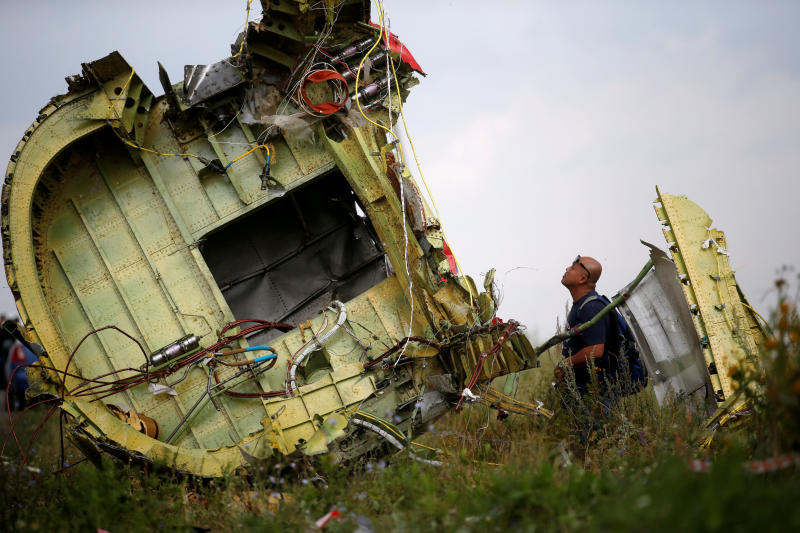Missile that downed Malaysia Airlines MH17 came from Russian military: Investigators
Sign up now: Get insights on the biggest stories in Malaysia

A Malaysian air crash investigator inspects the crash site of Malaysia Airlines Flight MH17 near the village of Hrabove in Ukraine on July 22, 2014.
PHOTO: REUTERS
Follow topic:
UTRECHT, NETHERLANDS (WASHINGTON POST,REUTERS) - A Dutch-led international team of investigators said Thursday (May 24) that a missile that downed a Malaysian Airlines jetliner over eastern Ukraine in 2014 came from the Russian military, opening the possibility that Dutch prosecutors could sue the Kremlin in connection with the attack that killed all 298 on board.
The Dutch Safety Board concluded in an October 2015 report that the Boeing 777 was hit by a Russian-made Buk missile, killing all passengers and crew, who came from 17 countries, including 38 Australians, but it had not previously made a direct link to the Russian military.
Criminal charges against the Russian military or Russia's government would likely exacerbate tensions between the Kremlin and the West even further, implicating Russian officials in the death of European tourists who were on their way to Kuala Lumpur.
Flight MH17 with 298 people on board, two-thirds of them Dutch, was hit by a Russian-made missile over territory in eastern Ukraine held by pro-Russian separatists. All those aboard died.
The July 17, 2014, incident led to a crushing round of Western sanctions against Russia. Since then, the Kremlin has clashed with Europe and the United States on issues ranging from Russia's support for Syrian leader Bashar Assad, the attempt to influence the 2016 US presidential elections and the March nerve agent poisoning of a former Russian spy in Britain.
The investigative team "has come to the conclusion that the Buk TELAR by which MH17 was downed originated from the 53rd Anti-Aircraft Missile Brigade from Kursk, in the Russian Federation," said Wilbert Paulissen, the head of the crime squad of the Netherlands' national police.
"All of the vehicles in the convoy carrying the missile were part of the Russian armed forces."
However, they left open the possibility that the missile could have been fired by another party. Rebel leaders said at the time they were receiving military assistance from Russia.
Investigators have been working to determine whether Russian troops shot the missile or whether it was Ukrainian rebels to whom the antiaircraft system had been supplied. The team said Thursday that the Buk missile system was towed onto Ukrainian territory shortly before the attack and towed back onto Russian territory shortly afterwards.
Paulissen said the investigators possessed "legal and convincing evidence that will stand in a courtroom."
At the time of the attack in July 2014, the battlefield in eastern Ukraine was seething with different armed groups. That spring, separatist fighters opposed to a new pro-Western government in Kiev seized control of broad patches of territory in Ukraine's eastern industrial heartland.
They were operating with Russian support, and Western journalists also spotted at least some Russian troops moving into eastern Ukraine that summer. The Russian government has long denied direct involvement in the conflict.
Flight MH17 took off from Amsterdam and passed over eastern Ukraine on its way to Kuala Lumpur, packed with Dutch tourists. In video footage from immediately after it was shot down, rebel fighters can be seen gathering in the sunflower fields where the bulk of the fuselage fell, celebrating what they thought was the downing of a Ukrainian military aircraft.
Their celebration turned to concern when they realized that it was a civilian jetliner.
The investigators on Thursday offered only open-source video and photographic evidence to support their conclusion that the missile came from a Russian military antiaircraft system. Portions of the evidence had already been reported by the Bellingcat research group.
But the international investigative team said their findings stood independently and that they possessed additional information to buttress their conclusions that they would unveil only in eventual courtroom proceedings.
Dutch prosecutors said in September 2016 that 100 people of interest had been identified in the investigation, while Australian and Malaysian officials expressed hope that suspects would be made public in 2017.
Indictments have yet to be released and the suspects are likely to be tried in absentia in the Netherlands after Russia used its veto to block a United Nations Security Council resolution seeking to create an international tribunal.

